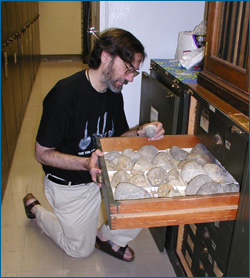
David argues that we need to understand mass extinctions because they have such a major impact on biodiversity. After all, we humans are the indirect beneficiaries of the last mass extinction: “The mammals were bit players in the nooks and crannies of the dinosaurs’ world until the dinosaurs were knocked out of the picture 65 million years ago. Then the mammals explosively diversified, and within ten million years, there were whales in the sea and bats in the sky.” Mass extinctions are key to understanding the biodiversity of the present and past — and unfortunately, if current extinction trends continue, they may also be central in shaping the biodiversity of the near future. Though that outcome — the sixth mass extinction — is one we would like to avoid, research like Jablonski’s provides us with clues about how it might operate and perhaps even be mitigated.
Though David is certainly motivated by the idea that his research could help our conservation efforts, that’s not why he keeps doing science. He does it because, in his words, “it’s a blast! Science is endlessly surprising and endlessly fascinating. The natural world is really complicated, and one of the great joys of studying the natural world is when it clicks into place and you learn something general about it. Every species is unique. Every organism is unique. But science is all about searching for patterns and generalizations. And the wonderful thing is that even for something as enormous as the distribution of species on earth or the massive extinctions that chopped our diversity in half, science can actually yield generalizations — general rules — about how the world works, that are testable in other situations. That’s really exciting and rewarding.”
Discussion and extension questions:
- What is background extinction, and how does it differ from mass extinction?
- What is a “natural” experiment, and how does it differ from a regular experiment?
- How did David test the idea that the rules of extinction vary between times of background extinction and times of mass extinction?
- What traits seem to protect marine mollusks from extinction during times of normal background extinction? What traits seem to protect marine mollusks from extinction during mass extinctions?
- Explain why David’s observations about extinction patterns during mass extinctions led him to hypothesize that widely spaced refuges protected some species during mass extinctions.
- Imagine that you are a paleobotanist and observe an unusual pattern in the fossil record. Before a mass extinction, the plants in a particular region are a mix of broad-leafed and narrow-leafed genera; however, the narrow-leafed genera tend to be more widely distributed than the broad-leafed ones. After the mass extinction, the species in that region are heavily skewed towards narrow-leafed varieties. List at least two hypotheses that might help explain why narrow-leafed species became so common after the mass extinction.
Get tips for using research profiles, like this one, with your students.
